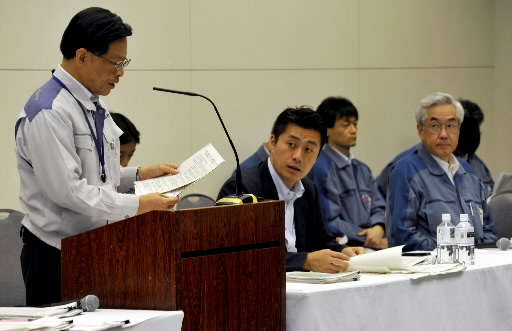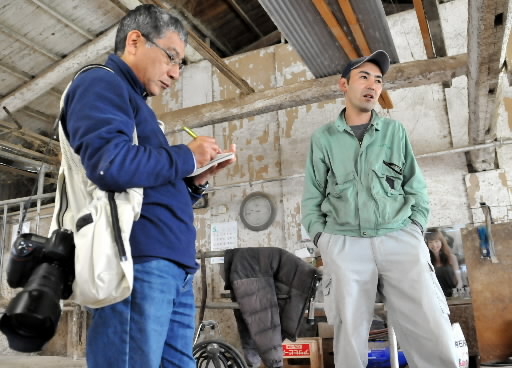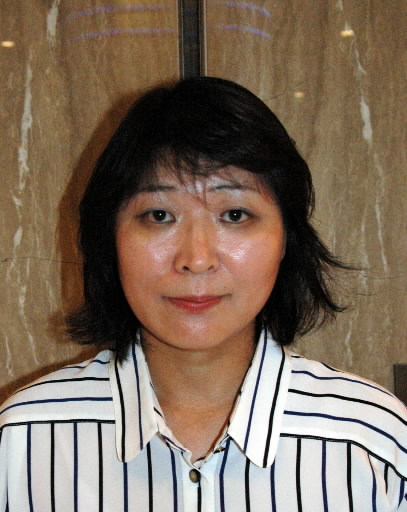Fukushima and Hiroshima: Accounts of 50 local residents, Part 2 [Special 2]
Jun. 29, 2011
Special: The control of information
by Yoko Yamamoto and Seiji Shitakubo, Staff Writers
Japanese government has given priority to own needs
Along with Hiroshima and Nagasaki, Fukushima has now entered human memory as another site in Japan scarred by nuclear damage. The Fukushima No. 1 (Daiichi) nuclear power plant is the scene of one of the world's worst-ever nuclear accidents. Despite such a catastrophic event, accurate information regarding the disaster has not reached local governments and their citizens since the crisis erupted on March 11. In a report submitted to the International Atomic Energy Agency (IAEA) on June 7, the Japanese government acknowledged its failure to properly disclose information and it expressed an apology to the international community. But how did the central government go about disseminating the information it held and in what ways was this communication insufficient? The Chugoku Shimbun examines the facts that have come to light in the three months since the crisis began.
The crisis erupts
Disparity between information from ham radio and public announcements
A high-pitched voice came shouting through the ham radio system: “White smoke is rising from the nuclear power plant.” It was the night of March 11, the day the Great Eastern Japan Earthquake struck. Through his ham radio device, Yoshio Abe, 40, an automobile safety inspector, was listening to the tense voices of the fire fighters leading the effort to evacuate people from the plant. Mr. Abe is a resident of the town of Kawamata in Fukushima Prefecture, about 38 kilometers from the Fukushima No. 1 nuclear power plant.
But through the regular radio placed near him, Mr. Abe heard the calm voice of Yukio Edano, the government's chief cabinet secretary, announcing, “The nuclear power plant is under control.” Speaking to himself, Mr. Abe said, “What is he saying?” By recognizing the great disparity in information between these two sources, Mr. Abe sensed that the central government was intent on concealing the worst of the crisis.
On March 12, angry voices continued to blare through Mr. Abe's ham radio: “Evacuate! White smoke is coming from the plant! It's going to explode!” Mr. Abe recalls that it was one hour after he heard these voices that a regular radio broadcast announced the hydrogen explosion in the No. 1 reactor.
The hydrogen explosion in the building housing the No. 1 unit took place shortly after the Nuclear and Industrial Safety Agency announced that the risk of an explosion had diminished due to a “venting” measure intended to lower pressure in the containment vessel. But on the heels of the explosion, with the situation deteriorating further as a result of delays in early countermeasures, such as injecting the reactor buildings with sea water and venting pressure from the containment vessels, the announcements made by the central government and the Tokyo Electric Power Company were marked by disarray. They continued to state such things as “Countermeasures for the No. 2 and No. 3 units are ready” and “The containment vessels are sound,” but these views proved to be overly optimistic, time and again.
The core meltdown of the reactors was then revealed. This possibility had been raised even back when the crisis erupted, but TEPCO continued to emphasize only the “possibility” of such damage in its statements. It took more than two months, until mid-May, for TEPCO to finally acknowledge the meltdown. Reportedly, the reactor cores had already melted down by March 14, and by March 15, most of the melted fuel had fallen to the bottom of the containment vessels.
Moreover, it wasn't until June 3 that the Nuclear and Industrial Safety Agency announced that the agency had detected tellurium 132, a radioactive substance, far back on March 12. This fact indicates that the reactor fuel exceeded a temperature of 1,000 degrees Celsius seven hours prior to the first hydrogen explosion. Hidehiko Nishiyama, the director general of the agency, explained that “Though we did not intend to conceal such information, we failed to adopt a mind-set of clarifying the facts to the public.” His explanation revealed the gulf between his side and the public's need for information.
When a criticality accident occurred in 1999 at JCO, a nuclear fuel processing plant, the Nuclear Safety Commission of Japan provided a report on the situation every day. This time, however, the commission was silent. Haruki Madarame, chairman of the organization, acknowledged: “The commission was unable to make announcements due to its role in assisting the main parties involved.” The prime minister's office, TEPCO, the Nuclear and Industrial Safety Agency, and the Nuclear Safety Commission were working on different wavelengths and took far too long to convey the information they held, which exacerbated a feeling of distrust both at home and abroad.
Radiation spreads
Returning home with no awareness of radiation levels
On the evening of March 15, in the village of Iitate, photojournalist Takashi Morizumi, 60, took pictures of his dosimeter, an instrument used for measuring radiation, to show the needle of the device swinging past the highest reading possible.
Mr. Morizumi did not imagine that the level of radiation found in a place 44 kilometers from the nuclear power plant would exceed 100 microsieverts per hour. In the past he had covered a number of stories out in the world on the damage to the surroundings of nuclear testing grounds and the damage wrought by depleted uranium shells, and he had continued to highlight the effects of radiation on the human body in his work. However, Mr. Morizumi recalled, “I didn't think I would be faced with the horror of radiation contamination spreading within Japan.”
Mr. Morizumi visited the town office of Futaba on March 13, when the area in front of the office recorded a radiation level of over 1,000 microsieverts per hour. He saw families there returning to their homes after the earthquake, having no knowledge of the radiation level in the community. “The central government is hiding information,” Mr. Morizumi said. “These residents need to know the facts right away.” He is making efforts to convey information on his blog and he stressed that people must seek out accurate information.
In the wake of the accident, the “System for Prediction of Environmental Emergency Dose Information,” known as SPEEDI, had produced a number of preliminary charts which predicted that the radioactive release from the plant would spread northwest and reach the village of Iitate. Although the central government was aware of this information, it was not made available to the public.
The government has long understood that radioactive materials do not spread in a concentric fashion, as past research, including an investigation of the “black rain” that fell in the aftermath of the atomic bombing of Hiroshima, has clearly showed. But the government considered the distance from the plant to be paramount and did not review its evacuation order until as late as April 11.
An adviser to the prime minister, Goshi Hosono, stated on May 2: “We wanted to avoid creating a panic.” He acknowledged that the government chose to control the information known, rather than informing local residents of their possible exposure to radiation. The SPEEDI charts, which amount to roughly 5,000 documents, were finally disclosed after this announcement.
Evacuation orders
Repeated changes after conditions at plant deteriorate
As conditions at the nuclear power plant deteriorated, the central government issued evacuation orders on three occasions. But these orders did not effectively reach residents. This was partly a consequence of the earthquake and tsunami, which knocked out emergency communication systems and caused a delay in providing information to local governments. Another reason is the fact that families were unable to access television news or the Internet due to a power outage in the region.
It is now clear that no communication was exchanged between the Fukushima Prefectural government and the four towns of Namie, Tomioka, Naraha and Hirono on March 11, the day the accident occurred. The city of Minamisoma and the village of Katsurao Village, which are not included in the Nuclear Disaster Countermeasures Program, did not receive information from the central government for some time, so they were forced to make judgments on their own without guidance. The evacuation order issued on the night of March 11 covered the area within a radius of three kilometers from the nuclear plant. But due to the delay in venting the No. 1 unit, the area covered by the order was widened to a radius of 10 kilometers early in the morning on March 12. Then, on the evening of March 12, when the hydrogen explosion took place at the No. 1 reactor building, the area of evacuation was again widened, this time to a radius of 20 kilometers.
In addition, on April 22, the government designated “planned evacuation areas,” which consist of communities located outside the radius of 20 kilometers. Residents of these areas were newly urged to evacuate. And on June 16, the government announced that it had established “recommended evacuation areas,” in which the government will assist with the evacuation of residents although such locations lie outside designated evacuation areas.
Issues for the future
Research and disclosure, to serve local residents
On June 7, the Japanese government, in a report submitted to the IAEA, definitively acknowledged its failure to properly disclose information. “The government should have disclosed the data compiled by SPEEDI immediately after the accident,” the report stated. “The government was so focused on the accuracy of information, it did not announce potential risks to the nation, and this created anxiety among the public.” Yet the government has still failed to clearly provide a projection for when the plant will be stabilized, information that local residents are naturally anxious to know, as well as a forecast for the reconstruction of the affected areas. A lack of information also continues to plague the problem of the ongoing spread of radioactive materials into the environment.
Mr. Hosono, the adviser to the prime minister, said, “In principle, all information will be disclosed.” He also announced, on June 17, the revised plan for stabilizing the plant, with the reactors expected to be cooled and contained by mid-January of 2012 at the latest. However, this announcement lacked such concrete information as a target date for lifting the evacuation order, information that is linked directly to the lives of evacuees. Mr. Edano, the chief cabinet secretary, also acknowledged on the same day that procedures for programs designed to provide support for sufferers, including temporary home visits and employment assistance, “are not necessarily advancing as initially planned.”
From this point forward, it is vital to provide local residents with more information that is needed for their lives, such as information regarding the actual conditions of the crisis and projections involving radiation contamination, as well as the possible long-term health effects of their exposure. Tetsuji Imanaka, a research associate at the Kyoto University Research Reactor Institute, has pointed out that “The measures taken to control information in the wake of the accident were just like those taken in the former Soviet Union following the accident at Chernobyl.” Mr. Imanaka called for research, including studies of the soil and examinations of internal exposure, to be conducted as early as possible, adding, “Research and the disclosure of information must take place swiftly so that these communities can decide their own futures.”
Interview with Hiroko Takahashi, assistant professor at the Hiroshima Peace Institute, Hiroshima City University
Contention that radiation exposure has no “immediate effect” is overly optimistic
The Chugoku Shimbun spoke with Hiroko Takahashi, 42, an assistant professor at the Hiroshima Peace Institute, Hiroshima City University about the shortcomings of the information made available by the Japanese government as well as other topics. Ms. Takahashi research interests include the subject of nuclear damage in the world.
I resent the announcement repeated by the central government for some time after the accident occurred. This announcement focused on the contention that the levels of radiation recorded within a radius of 20 or 30 kilometers from the nuclear power plant were “not significant enough to have any immediate effect on the human body.”
What we find horrifying is that late-onset damage, including cancer, can develop several years or decades later. The exposure that is now occurring, which involves exposure to low doses of radiation over a long period of time, is the first such experience in human history. The government should have announced: “We don't yet know what the effects might be. People who have been affected must take the utmost care with their health.”
The situation today is much like what was happening in the United States in the 1950s. At that time the United States was engaged in an arms race with the former Soviet Union and Americans were terrified of the possibility of a nuclear war. The U.S. government, though, was telling its people that radiation wasn't something to be scared of, while failing to inform them that cases of leukemia among A-bomb survivors in Hiroshima and Nagasaki were increasing in number.
Japan, the only nation to have suffered atomic bombings, should be the most cautious nation in the world when it comes to the effects of radiation, but in reality it has taken an indulgent attitude toward TEPCO. The Japanese government listens only to the voices of opportunist scholars in the so-called “nuclear power village,” a network of insiders. The fact that the government insisted on viewing the spread of radioactive materials from the plant in a concentric fashion is a symbol of this problem. The media, too, should reflect on their role in all this, as they were unable to point out the falsehoods perpetuated by the central government and TEPCO.
From here, there must be a thorough investigation to confirm the facts of the disaster at the nuclear plant. Reforms must then be made so that all relevant information can be disclosed to the public.
(Originally published on June 22, 2011)










